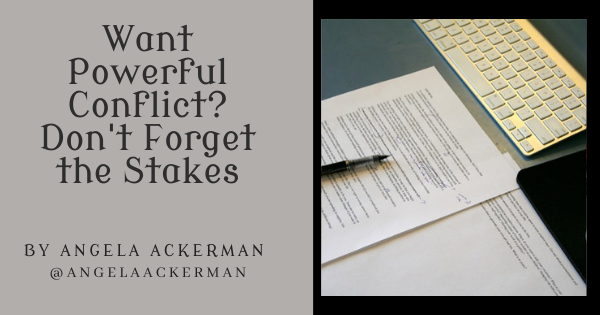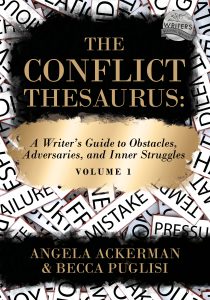by Angela Ackerman, @AngelaAckerman
A common writing misconception is that conflict automatically means reader engagement. After all, story experts are always ringing the conflict bell (me included), telling writers to include lots of it to make sure things aren’t easy for your characters. And it’s true; we should have lots of meaningful conflict in the story to ensure they are challenged, stressed, and forced outside their comfort zone.
But conflict alone won’t pull your readers in.
Don’t mishear me–as a reader, I like fictional car chases, wedding sabotage, and homicidal maniacs at the bedroom window as much as the next person. But for the conflict craziness to really hit home, I need to know why it’s happening, and why it matters. In other words, something meaningful must be at stake to make me care.
Think about it this way. When bad things happen to bad people, how do you feel? Let’s say a pipe bursts at a neighbor’s house, the same guy who constantly complains to the homeowner association because he doesn’t like the rainbow flag flying over your deck. Or a restaurant that once gave you food poisoning is shut down by the health department. Other than a bit of schadenfreude, do you feel anything substantial? Is your day (or life) impacted in a relevant way?
But, when bad things happen to good people, that’s a different story. If your sister-in-law goes into labor far too early or your best friend is jailed because her wayward stepson is dealing drugs out of her basement, you don’t just shrug and move on. You’re making calls, trying to figure out what you can do, how to help. You’re invested because you care about the people involved and what’s happening to them.
Stakes Reveal What’s Most Important to the Character
For conflict to matter, something meaningful needs to be at stake: a painful cost incurred if your character fails to navigate the situation successfully. If the retired munitions expert doesn’t defuse the bomb in time, it goes off and kills a building full of people. Or if our henpecked heroine can’t stop her toxic family from running her life, she’ll forever lose the man she loves. When each new problem has a serious or else attached to it, the character must act, even when there’s danger or they are out of their depth. Their desire to avoid these negative consequences becomes a big part of their motivation for achieving their goal.
Stakes, like conflict, should show up in your story like a bumper crop of rotten apples, increasing tension and raising the cost of failure by the bushel. And while the goal is to create stakes so high the character can’t turn back—not even when she’s staring down her deepest fears—the consequences of failure are up to you and how evil you’re feeling. To get you started, consider the categories below.
Far-Reaching Stakes, sometimes called public stakes, are those that include loss for others if the protagonist fails. If a bomb goes off, the protagonist may die, but so will everyone else in the building. And it goes beyond them too; loved ones standing anxiously behind the police tape will also be impacted. Maybe the city loses the distinction of being the safest in America. Maybe a cure for a disease is housed in a laboratory within the building, and it will be lost if the bomb goes off. Lots at stake.
Moral Stakes are in play when someone’s beliefs are at risk. Imagine a police officer being offered a bribe to overlook a crime. If he refuses, he holds true to his moral code and identity as an officer, but the powerful person offering the payoff will be sure to end his career. If he takes the bribe, he reaps a temporary reward but sacrifices his values and his identity. Moral stakes can cut both ways and have the added benefit of revealing some of your character’s deepest layers to readers.
Primal Stakes, also called death stakes, involve the death of something significant: innocence, a relationship, a career, dream, idea, belief, reputation, or a physical life. Death takes something important from the character, something that matters. And if it matters to your character—provided readers care about them—it will matter to them too.
Connect Stakes to your Character
Stakes should touch your character on some level, even in the case of far-reaching stakes. If there’s no reason the outcome really matters to the protagonist, he’s going to look at the task and think, Well, this isn’t my problem. We need him to believe it is his problem, otherwise why should he risk hardship, danger, and perhaps even death? So, we give him skin in the game by making things personal and endangering something or someone important to him.
Mixing together different types of stakes will not only make the problem at hand more interesting for readers, it makes the struggle over what to do more realistic. In the real world when a challenge or situation comes along that’s dire or threatening, we act. But far more often the problem we’re faced with requires more than instinct, and there are layers to the situation. We weigh and measure, making calculations over how to respond. For example, something might feel morally wrong to do, like tell a lie, but if it is for the greater good, we might do it. Or if lying might light a fuse to a relationship we care about, we might tell the truth even though it’s humiliating, dangerous, or costs us an opportunity we worked hard to secure. The point is, we look at all the angles to puzzle out what we should do next, and so our characters should, too.
The Final Piece: Making Readers Care about the Character
Stakes are a necessary part of effective conflict, but another crucial piece is the reader’s attachment to the character. If readers don’t care, they may be mildly curious as to whether the protagonist will succeed, but they won’t be invested in the outcome.
So how do we make readers care? Well, it goes beyond making a character likeable or talented; it really comes down to their inner landscape: their morals and values, vulnerabilities and wounds, their fears and needs. By chipping through our character’s tough exterior and revealing their inner thoughts, emotions, and desires, readers come to know them and identify with their struggles. They may share an insecurity. They may experience some of the same doubts. Maybe the character is torn between following a dream and pleasing others, something readers can relate to because they’ve sat in that chair before. These moments become emotional touchstones because readers can connect with what the character is facing and feeling. (Here’s a tool to help with deep-level brainstorming.)
Ultimately, what’s at risk for your character is the goal. But for writers, there’s risk, too. Readers will close the book if stakes are mismanaged, they don’t care about a character, or the conflict is too low. So, focus on drawing readers in. Work at getting your character’s situation firmly into the heads of your readers. Embed an invisible hook so every time they put the book down, they’re thinking about what will happen next, how the character’s going to solve the problem, and what other forces might step in to complicate matters. Make your readers so emotionally involved that they fear for the character and don’t want anything to happen to them.
Need More Help with Conflict and Story Stakes?
The Conflict Thesaurus: A Writer’s Guide to Obstacles, Adversaries, and Inner Struggles (Volume 1). It’s packed with ideas on how to apply meaningful conflict to reveal your character, challenge them, and keep the story tense and on track. It also digs into a plethora of conflict scenarios to help you plot fresh scenes.
Angela Ackerman is a writing coach, international speaker, and co-author of The Emotion Thesaurus: A Writer’s Guide to Character Expression and its many sequels. Her bestselling writing guides are available in eight languages, and are sourced by universities, recommended by agents and editors, and used by writers around the world. She’s also one half of the popular site, Writers Helping Writers, and co-founder of One Stop for Writers, a creativity portal loaded with one-of-a-kind tools, resources, and a Storyteller’s Roadmap that makes planning, writing, and revising a novel almost criminally easy.
The Importance of Stakes in Your Story by @AngelaAckerman : Click To Tweet
Photo credit: ali edwards on Visualhunt.com



Thanks so much for writing on this important topic, Angela! Even in the gentle world of cozy mysteries, stakes are vital to explaining the “why” of the stories…why is an amateur getting involved in the case and what does she have to lose if she doesn’t? Wonderful tips and explanation here!
Thank you so much for having me, Elizabeth! I know when I started writing I thought in terms of “I have to throw rocks at my character” and would just try to dream up interesting ways to cause trouble for them. But conflict’s job is more than that, and it can do so much for the story when we use it the right way. It allows us a terrific opportunity to show, not tell, by revealing what’s meaningful and what the character really cares about. Readers always need to know why characters do what they do, and “because they want X goal” isn’t enough. We need to go deeper to make readers really care.
Far-reaching stakes play a big part in my next book and hopefully I’ve made the readers care.
That’s great, Alex! Far-reaching stakes can be powerful, and we’re all living that right now with Covid. It’s a great time to use these stakes in a novel because readers are all experiencing it and so will identify better with how disruptive and terrible they can be.
Very good advice. Thank you!
Thanks for reading and commenting, Elizabeth!
If there’s not enough to lose, the reader won’t care as much, which is why those stakes have to be high.
Exactly!
Great advice! I agree – stakes matter when we care about the characters involved!
The Conflict Thesaurus is a fabulous resource!
Hi Elizabeth – Angela’s books have been great reference works and I’m sure this Conflict Thesaurus will offer the same value. Interesting read – thank you … Hilary